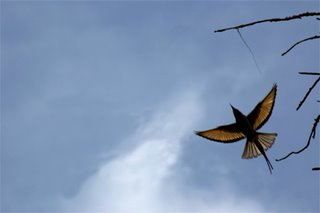Interestingly, others, scientists, apparently always were. Its an interesting contrast and the reasons for why are also interesting. I hope you can access the science url.
What is also interesting is that while the photograph gained acceptability at one stage as acceptable 'data'. It has now to an extent lost its credibility and journals are now beginning to look at ways of catching fraudsters. The doctored stem cell images from Dr Hwang Woo-suk being one of the more recent high profile scandals.
Some like to blame Digital imaging and photoshop for this. I'm not so sure; as many have pointed out before, manipulation is not new. Digital imaging makes it easier, it wasn't impossible before and people did it. Summerlin and his felt tip markers are a famous example . But having done some darkroom work myself (not in science, in photography), I can certainly tell you, dodging and burning ain't hard baby! Heck that would be enough to make gel bands appear and disappear.
The other area where a viewer tends to see the photograph as witness is journalism. Now I really can't say this about India, but elsewhere, the notion of journalists as seekers of truth has always been popular. And by extension the photojournalist. Yet Migrant mother, Dorothea Lange's arguably most famous photograph, has its own elements of deception. It is believed that she directed the photograph and perhaps lied about their stories in an attempt to make them sound worse than they were. OJ Simpsons pictures in TIME were much talked about, images of Iraq were doctored.
Even when images aren't doctored, leaving in or leaving out context can make the interpretation of their content controversial. (If you're thinking about more recent obviously emotional pictures, the emotion is precisely why I decided to leave it out.). Even which photographs get published and which left out are profound indicators of the degree of deception that goes on in public discourse.
The motivation behind such 'manipulation', post or pre-exposure, of course, is that photographers want to tell a story. That every image has an intentionality behind it. Sometimes the details before them do not fit that vision. If you ask me, Langes image isn't a lie. Some migrant families did face the situations that she talked about and the image had the effects that she wished it to. Off course she gained from it as well, but there can be no doubt that the intent was not to merely to cement her reputation as a photographer, but to help. I think her life attests to that.
So when is a photograph a lie? I believe it is no more a lie than a truth. Unless of course it asserts its literal veracity and isn't true. This can also be hard to judge, whether its asserts any such thing.
What are the standards to which a photograph is to be held? The same that you hold any representational art to, all that was 'out there' is now boxed in a small space through the filters of many peoples perceptions, the photographers, the editors and yours.
Are we to read it as 'literal truth'? Unless you enjoy self deception, I suggest you dont.
 So far, this is advice to people looking at pictures, how they might interpret them. But I also take pictures, so how do i approach that? (And btw I do manipulate, I've added moons, I've removed a branch and dust spots, created composites and the usual levels, curves, etc. )
So far, this is advice to people looking at pictures, how they might interpret them. But I also take pictures, so how do i approach that? (And btw I do manipulate, I've added moons, I've removed a branch and dust spots, created composites and the usual levels, curves, etc. )So the other direction I personally come to this debate is the idea in nature photography that images should not be manipulated (especially after the advent of digital tech). Guy Tal makes an impassioned appeal for why he thinks its bollicks. I personally think its impossible, for reasons stated before, and stated again i.e. everythings manipulated.

Is it then a question of degree? But I remember my Logical fallacy 101 lessons, truth isn't heirarchical. There isn't a 'higher' or 'truer' truth, theres just one consistent truth. So no, we cant take recourse to that.
I believe, theres only one thing in any image, a realisation of an intention, the photographers or if its part of a larger piece, that of whoever put that together. The realisation maybe good or poor thats another issue. But the image can depending on your purposes contravene any rule of reality.
From a photographers point of view, if I present my images in the context of representing nature, biology, I don't want them contravening biological reality. But that doesn't mean not manipulating, it means not contravening biological reality, so thats my brief.
If I present them as art, I don't have too many rules, I just try and keep from killing my own intention. Like the intention of posting short!
No comments:
Post a Comment